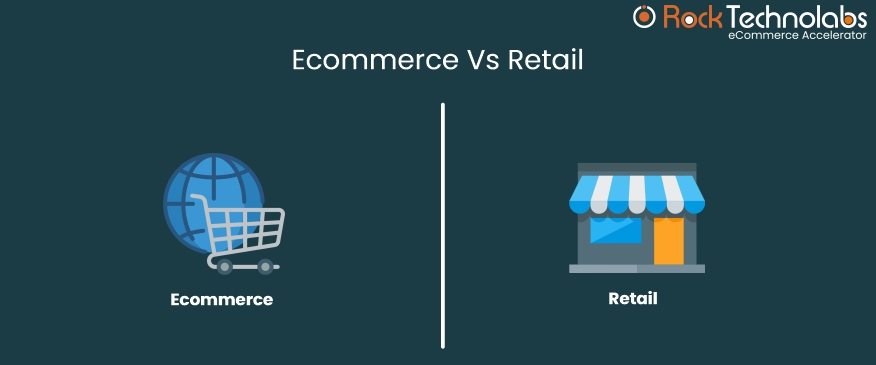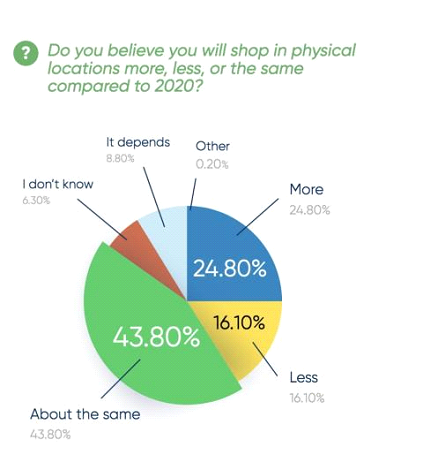E-commerce VS Retail: Stats, Differences, and Advantages

For all the business owners who have a physical store, we have a question for you all of you!!
With everything you have experienced in the last two years due to pandemics, will you still focus on selling products or services at storefront into 2022 or will you move to online Ecommerce stores after looking at the growth in online shopping? Is ecommerce overtaking traditional brick-and-mortar retail? Yes. It is. What? Do you want more?
Well alrighty then, let’s explore the e-commerce vs retail comparison to find out what the future holds. Is it game over for physical stores? Or will they find an edge to compete with the eCommerce world without losing the essence of their brand?
Ecommerce has exploded this year compared to 2019-2021. Ecommerce is the future. How long until you jump onboard?
In this blog, we have covered the difference between ecommerce and retail.
What is Ecommerce?
Ecommerce which is also known as online shopping or electronic commerce is a process of purchasing and selling products and services online over the internet. It is a commercial transaction that takes place electronically on the internet.
Types of Ecommerce:
⦁ Business to Consumer (B2C):
If we talk about one of the most popular e-commerce models, then it’s none other than B2C e-commerce. Business to consumer is when you buy an item from an online retailer which means the sale or a transaction is taking place between a business and a consumer.
⦁ Business to Business (B2B):
Business to Business e-commerce refers to sales of products or services from one business to another business, like a wholesaler and a retailer, manufacturer, and wholesaler. B2B e-commerce isn’t consumer-facing, and usually involves products like software, raw materials, or products that are combined. Using B2B ecommerce, manufacturers can sell products directly to retailers. You might also find B2B eCommerce case studies or articles on such platforms that highlight their successful implementations and best practices.
Recommended Read: Top B2B Ecommerce Trends and Statistics
⦁ Direct to Consumer (D2C):
Direct to consumer e-commerce is one of the newest ecommerce models where brands seek their products and services directly to their end customer without going through a wholesaler, retailer, or distributor. Trends within the D2C category are never the same, they are continuously changing. Social selling via platforms like Facebook, Instagram, Pinterest, etc. is some of the popular platforms for direct-to-consumer sales.
⦁ Consumer to Consumer (C2C):
The sale of a good or service to another consumer has been considered a Consumer-to-consumer e-commerce model.
⦁ Consumer to Business (C2B):
C2B refers to how an individual sells their products or services to a business organization. Consumer to Business encompasses influencers offering photographers, exposure, freelance writers, consultants, etc.
Recommended Read: 6 eCommerce Challenges and Their Solutions
What is Retail?
Retail is a process where merchants sell their products or services through a storefront location in person. It is the sale of products in a physical location where the buyer and the seller meet in person, and the buyer can directly interact with the products.
Retail can be conducted in a number of ways: in a brick and mortar establishment like a grocery store, shopping mall, person-to-person sales, etc.
Ecommerce vs Retail Statistics:
If we talk about e-commerce vs brick-and-mortar sales, we have witnessed the rapid growth in online shopping after the COVID-19 pandemic. But still, there is a large segment of the population who wants to have in-store experiences.
According to Raydiant’s second annual State of Consumer Behavior Report, 46% of respondents said that they prefer to purchase in-store rather than shopping online given a choice.
Some of the key findings have been listed in the State of Consumer Behavior 2021 report are:
- 33% of customers prefer in-store shopping because they like to see, feel, and interact directly with the products. while 26% said that they enjoy the overall experience of shopping in person.
- 40% of respondents have visited physical locations less frequently since the COVID-19 hit.
- Brand loyalty is lacking. 48% of respondents said they had replaced the regular products they purchase at physical stores with alternative competitors’ who sell products online.
- Brands are really making efforts to improve the offline customer experience. 29.8% of respondents said they have gotten better in-location customer service in the past year.

What is the significant difference between traditional business and e-commerce?
| Comparison | Ecommerce | Traditional Business |
|---|---|---|
| Definition | E-Commerce is a form of online shopping where users can buy products and services from their electronic devices such as a laptop, mobiles, or tablets. | Traditional business is a traditional approach to purchasing products and services face to face which involves in-person dealing. |
| Transactions | Online | Manual |
| Usage | Save valuable time and money. | Old and ancient ways are still in usage where the digital network is not reachable. |
| Process | Easier to use and operate with basic digital gadget knowledge. | This process can be followed by any person irrespective of education or knowledge. |
| Customer Interaction | Screen to Face | Face to Face |
| Mode | Electronic or digital mode only. | Non-electronic or manual form. |
| Time | 24 X 7 X 365 | Limited time based on the type of business. |
| Purchase | Trying products before purchasing is not possible in online shopping. | Trying before your buy product is applied in this business model |
| Marketing | One-to-one marketing | One-way marketing |
| Business | More business can be easily done and managed without any hassles | Difficult to perform more business in this ecommerce model |
| Maintenance | Easier to maintain this as the only warehouse is enough to store the products. | Cost-effective as you need to showcase the products to attract the customers. |
Pros & Cons of ECommerce & Retail
Benefits of eCommerce
- Wider Customer Base
- Faster Buying Process
- Speed and Flexibility
- 24/7 option for customers to purchase
- Lower costs
- Your trading hours are pretty much-unlimited
- Easy to scale up
- Quick Response To Market Demand and Consumer Trends
- More Opportunities To “Sell”
- Personalized Messaging
- Increased Sales With Instant Gratification
- Easy to Showcase Bestsellers
- Gain Access to Customer Data Easily
- Grow Your Business Organically with Content
- Global accessible
Cons of eCommerce
- Lack Of Personal Touch
- Lack Of Tactile Experience
- Price And Product Comparison forces many merchants to compete on price and reduce their profit margin.
- Need For Internet Access
- Credit Card Fraud
- IT Security Issues
- Customers Can’t Try Before They Buy
- Complexity In Taxation, Regulations, and Compliance
- Substantial loss of revenue and customer dissatisfaction even with a few minutes of downtime or technology hiccups.
- Ecommerce Is Highly Competitive
- Shipping Times Can Be a Lengthy
Benefit of a Retail
- Simple business model which makes building and launching the business more seamless.
- You are your own boss!
- Face-to-face interaction
- Develop a local following by selling your products at farmers’ markets, craft shows, exhibitions, or even local storefront businesses! This gives you access to loyal customers and additional revenue streams.
- Better margins than wholesale
- Direct contact with target audience
- More opportunities to create brand personality
- Faster turnover of inventory
Cons of Retail
- Time commitment
- High overhead expenses
- High employee turnover
- Large cash investment upfront
- Locally accessible
Ecommerce Vs Retail Future
Retail isn’t going to die out completely and eCommerce is not overtaking retail 100%. Not every e-commerce store involves retail and not every retail store involves e-commerce. So, what is the core difference between eCommerce and retail? Retail applies to B2C sales transactions that occur through offline or online touchpoints. While in e-commerce, the only online transaction takes place and supports all types of business models, including B2B, B2C, C2A, etc.
As you can see, it’s not about choosing between ecommerce vs brick and mortar stores, but rather adopting the new trends such as voice ecommerce, contactless commerce, sustainable ecommerce. There is no harm in selling products online alongside your retail store, as this way you open up an enormous new market without losing your brand’s identity.
While eCommerce is the future of business, the retail industry remains an important aspect. Building your online eCommerce store can help you significantly increase store sales, conversions, and revenue. Need help to scale your business online? Contact us!





